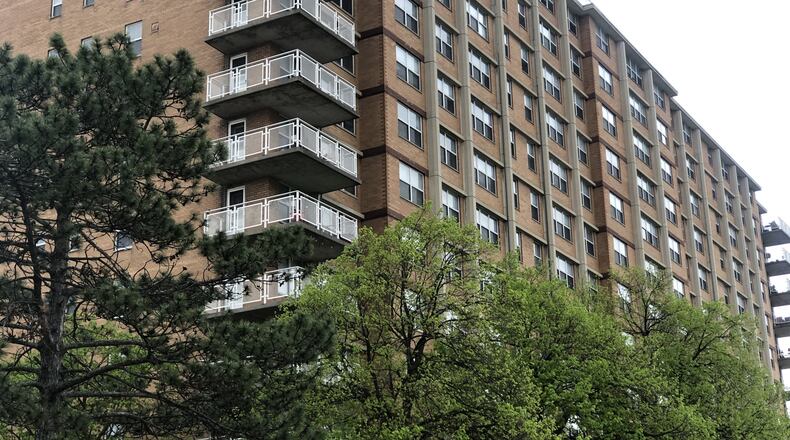But landlords and apartment managers fear that nonpayment of rent could surge in May, because of deteriorating economic conditions and growing job losses.
Around 630,000 of the more than 1 million Ohioans who have been laid off in the last six weeks are renters, according to estimates from the Coalition on Homelessness and Housing in Ohio.
Renters who are struggling financially need to talk to their landlords and apartment managers because they may be able to get on a payment plan or figure something else out, Cobble said.
“We are not looking to evict people,” he said. “We are working with residents and communication is key.”
Coronavirus: Complete Coverage by the Dayton Daily News
A survey of Greater Dayton Apartment Association members found that most received 95% of rent payments owed in April, said Cobble, who is also the vice president of Oberer Management Services, which manages multiple local properties including the View at Dayton Towers and the St. Clair Lofts.
Collections were pretty standard last month, Cobble said, even though the nation saw massive job losses in late March, including nearly 60,000 workers who were laid off in the seven-county Miami Valley region.
But landlords and managers are very nervous about May payments, because of soaring unemployment.
Since March 29, more than 77,500 unemployed workers filed initial jobless claims in Butler, Champaign, Clark, Greene, Miami, Montgomery and Warren counties, according to Ohio Department of Job and Family Services data released Thursday.
Hopefully, renters who have lost their jobs have received stimulus checks or unemployment compensation that can help cover housing costs, Cobble said.
Many apartment managers and operators are offering payment plans, waiving late fees and providing other flexible arrangements to help residents in dire straits, he said.
MORE: Stimulus payment problems in Dayton region: too much, too little, few answers
The Greater Dayton Apartment Association represents over 37,000 apartment units in the region, from Troy to Middletown to Springfield.
“We’re encouraging everyone to be open and work with residents to give them every opportunity to make those payments,” Cobble said. “We’re all in this together, so let’s figure out a way to make this work for everyone.”
Oberer Management Services has a portfolio of about 4,000 apartment units, and less than 1% of residents were on a payment plan last month, Cobble said.
But low-wage workers, who tend to be renters, have suffered some of the largest layoffs, and even before the pandemic, nearly 400,000 households in Ohio were spending more than half of their incomes on rent, said Bill Faith, executive director of the Coalition on Homelessness and Housing in Ohio.
In Ohio, an estimated 630,000 unemployed tenants owe a combined total of $500 million each month in rent, and many will be unable to meet their obligations this month, Faith said.
On Thursday, Faith joined other affordable housing advocates to call on federal lawmakers to approve emergency rental assistance to low-income residents.
“This virus-induced recession and the unemployment that goes with it disproportionately is harming the people who can least afford it,” Faith said.
Dejanee Coaston, a Dayton-area renter who was unable to work after developing COVID-19 symptoms and had to self-quarantine, said rental assistance would be a big help.
“I really need help and I don’t know what is going to come of all this,” she said.
MORE: Patrol: More people driving 100-plus mph on Ohio roadways as overall tickets plummet
April was a difficult month, but May will be even harder for residents and rental housing providers,
The National Apartment Association has encouraged its members to work with residents and provide relief when possible, such as waiving fees and offering payment plans, said Don Brunner, vice chairman of the National Apartment Association and chief operating officer with BRG Apartments in Cincinnati.
However, most of the industry is made of small owners who cannot afford to lose rental income without harming the quality of their properties or possibly even losing ownership, he said.
“Rent powers the apartment industry as gasoline powers cars, and if these payments stop, there will be dire consequences for residents, owners and operators and the economy,” Brunner said. “Rent dollars pay the mortgage, property taxes, payroll, maintenance and utilities and the quality and future of the property is jeopardized if these financial obligations are not met.”
Nationally, about 91.5% of professionally managed apartment households made a full or partial rent payment by April 26, said Caitlin Walter, vice president of research with the National Multifamily Housing Council, which surveys 11.5 million apartment units.
By comparison, about 95.6% of apartment tenants made at least partial payment during the same period in 2019, Walter said, and 94.6% of tenants made payments by late March.
“This shows that people who can pay are paying their rent,” Walter said. “People understand that landlords need to meet their financial obligations too.”
About the Author

